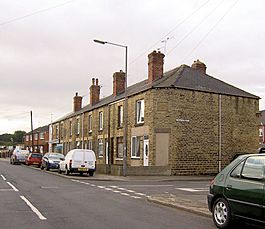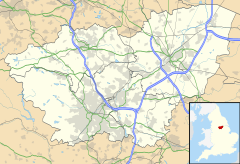Thurnscoe facts for kids
Quick facts for kids Thurnscoe |
|
|---|---|
 Togo Street, Thurnscoe |
|
| Population | 8,687 (2011 census) |
| OS grid reference | SE454057 |
| Metropolitan borough |
|
| Metropolitan county | |
| Region | |
| Country | England |
| Sovereign state | United Kingdom |
| Post town | ROTHERHAM |
| Postcode district | S63 |
| Dialling code | 01709 |
| Police | South Yorkshire |
| Fire | South Yorkshire |
| Ambulance | Yorkshire |
| EU Parliament | Yorkshire and the Humber |
| UK Parliament |
|
Thurnscoe is a village located in South Yorkshire, England. It is part of the Metropolitan Borough of Barnsley. The village is about 9 miles (14 km) from Barnsley and 8 miles (13 km) from Doncaster. You can get there by train, as it has its own Thurnscoe railway station, and also by bus. In 2011, about 8,687 people lived in Thurnscoe.
Contents
A Look into Thurnscoe's Past
Thurnscoe is in the heart of the Dearne Valley. Long ago, it was mostly a farming village. In Roman times, an old Roman road called Ryknild Street passed through. This road followed a path that locals called "the cow track."
The name Thurnscoe comes from an old Norse language, meaning "Thorn Tree Wood." Some parts of the village used to belong to Roche Abbey. They dug up a type of rock called Magnesian Limestone from an area known as "Cave Wood." This limestone from Thurnscoe was quite important for trade in the Middle Ages.
Old Buildings and Village Life
The oldest building in Thurnscoe is the Church of St. Helen on High Street. It was first built in 812 by the Angles. Later, in 1087, the Normans rebuilt it. Only the tower from the original church remains today. During repairs, workers found Anglo-Saxon remains, including a skeleton. This shows the site was important even before the Christian church was built there.
Other old buildings in the western part of the village include Thurnscoe Hall, which is now a nursing home. There's also the Blacksmith's Cottage, built in 1715, near St Helen's Church. The Red House Cottage on High Street is the very oldest building in the village, dating back to the 16th century.
Before coal mines opened, Thurnscoe was a rich farming area. It was famous in the Middle Ages for its excellent cheese. There were many farms and fields around the village. However, most of these farms are now gone, and modern houses cover many of the old fields.
The Mining Years and Beyond
Coal Mining started in Thurnscoe in the 1600s with small surface mines. But it really grew after the Hickleton Main Colliery found a large coal seam in 1894. Almost all the houses east of the railway were built for coal miners. St. Hilda's Church was also built in 1935 for the mining community.
In 1980, mining provided jobs for 81% of all men in the area. Thurnscoe was one of many mining villages in Yorkshire that faced high unemployment. This happened when the British coal mining industry changed a lot in the 1980s. Hickleton Colliery joined with Goldthorpe mine in 1986, but then both closed in 1994.
After the mines closed, the large pile of waste from the pit was turned into "Phoenix Park." This park has a climbing wall, picnic areas, and art made by local people. Poems by a local resident, Desiree Chipp, are carved into stones at the park entrances.
Many historic buildings were taken down towards the end of the 20th century. These included the old Victorian primary schools, the Station Hotel, and the Broadway Buildings Ballroom. The village once had a swimming pool, a cinema, and a busy market. The old market site is now a car park for a Home Bargains store that opened in 2017.
New social housing has been built where the old colliery buildings used to be. This project cost £2.1 million and also helped improve the area around the social club and public spaces.
Flooding Challenges
A small stream runs through the western part of Thurnscoe. It goes under the village in a covered tunnel. In 1987, this stream flooded during heavy rains, threatening a local primary school and flooding homes. Another flood happened on June 26, 2007. Water was very high in some parts of Thurnscoe, even up to waist level. An old people's home had to be moved because of the flood.
Thurnscoe's Landscape
Thurnscoe's land was shaped by glaciers long ago. It has gentle slopes, good clay soil for farming, and no large, uneven rocks. The village used to have many springs and small streams called dykes. High Street, which is not the main road, is a winding street that was once a river. Many of the dykes were put into underground pipes in the 1960s and 1970s because flooding was a common problem in the lower parts of the village.
A railway line divides the village into Thurnscoe and Thurnscoe East. This railway was originally built to serve the coal mine. People who live there don't see them as separate villages. Locals call Thurnscoe East "the top end." This eastern side has many low-cost terraced houses that were built for miners. The western side is also known as "Old Thurnscoe" or "the bottom end."
Sports and Recreation
Thurnscoe has a history in sports. Thurnscoe Park Avenue F.C. played in the FA Cup from 1919 to 1921. Thurnscoe Victoria F.C. also played in the same competition in the 1930s and 1940s. The village is also home to Thurnscoe Institute Cricket Club. There is a sports ground near the village's Asda supermarket.
Famous People from Thurnscoe
- Billy Whitehurst: A former football player who played for teams like Hull City and Newcastle United. He was born in Thurnscoe.
- Leonard Parkin (1929–1993): A journalist and news reporter for ITN. He also worked for the BBC.
See also
 In Spanish: Thurnscoe para niños
In Spanish: Thurnscoe para niños


